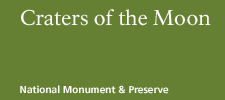|
Where's the volcano?
After driving past mile after mile of rugged lava flows, you may have arrived here expecting a gigantic volcano with steep slopes and a summit crater -- like Mount St. Helens. But the volcanoes at Craters of the Moon do not fit that description. The eruptions here, called "fissure eruptions", occurred along cracks in the earth's crust. The eruptions were of very fluid basaltic lava from which gases could easily escape. Without high gas pressure, eruptions tend to be very mild and produce small cinder cones and extensive lava flows. There are more than 25 cinder cones at Craters of the Moon, each one a small volcano.
When did the eruptions occur?
Volcanic activity occurred on the Snake River Plain for many millions of years. But Craters of the Moon was formed by eruptions that started only 15,000 years ago and represents the last period of active volcanism in this area. The most recent activity occurred 2,100 years ago. A walk on the North Crater Flow Trail allows you a close-up view of one of these recent flows.
Did Indians ever live here?
Because of the harsh conditions, none of the local Indian tribes made a permanent home in the lava flows. However, numerous Northern Shoshoni artifacts, temporary shelters, and hunting blinds have been found in the monument. This indicates that they did venture into the area occasionally, probably to hunt and gather tachylite (a very dense form of basalt) for arrow points.
Who planted all the flowers?
In the late spring, tiny wildflowers adorn the cinder slopes of the monument. Because they are so evenly spaced, they appear to have been planted in neat rows. Not so! Plants here must compete for a very limited amount of water; consequently, they cannot grow too close together and survive. The plants space themselves naturally according to the availability of limited resources.
Did the astronauts really train here?
The second group of astronauts to walk on the moon visited Craters of the Moon in 1969. Although they did not actually train here, they did study the volcanic geology. They were also able to explore an unusual and harsh environment in preparation for their trip into space.
Does the wind always blow like this?
No -- sometimes it's worse! Because Craters of the Moon is higher than the surrounding area (5900 feet in elevation), it intercepts the prevailing southwesterly winds. Afternoon winds can be expected almost every day, but usually die down in the evening.
How did the monument get its name?
Local legends made references to the landscape resembling the surface of the moon. Some even referred to the area as the "Valley of the Moon." It became known as Craters of the Moon when Robert Limbert used the name in an article for a national magazine. Limbert was the first man to thoroughly explore and promote the area. The name became official with the establishment of the monument in 1924.
Will the volcanoes erupt again?
Craters of the Moon is a dormant rather than an extinct volcanic area. The volcanoes here are not dead, only sleeping. Indications of impending eruptions -- earthquakes, the opening of steam vents, and ground swelling -- have not occurred recently. However, geologists believe that the area will become active within the next 1,000 years.
|








